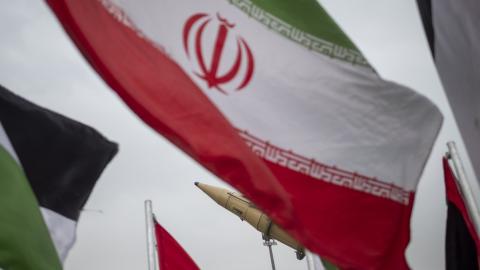In his testimony to the 9/11 Commission, then-CIA Director George Tenet described the harrowing intelligence picture that had emerged in the summer of 2001. “The system was blinking red,” he famously recalled. What followed, of course, was the well-documented, multi-agency failure to prevent an avoidable disaster that changed the course of history.
The system is blinking red again, and the American response appears frighteningly familiar.
Earlier this month, the International Atomic Energy Agency (IAEA) confirmed that its inspectors in Iran had discovered uranium particles enriched to about 84 percent purity. Most reports have noted that this is just shy of the 90 percent level generally considered to be “weapons grade.” Others correctly point out that uranium enriched to around 80 percent fueled the atomic bomb dropped on Hiroshima in 1945. Almost no one mentions that Iran has no civilian need to enrich uranium in the first place.
During the nearly four years leading up to the IAEA’s finding, Iran has engaged in increasingly grave violations of its international nuclear obligations, only some of which derive from the 2015 Joint Comprehensive Plan of Action (JCPOA). Iran still refuses to cooperate with at least three separate IAEA investigations of undeclared nuclear materials, activities, and sites, in violation of its commitments under the Nuclear Non-Proliferation Treaty.
With Iran’s long history of nuclear lawbreaking, the discovery of undeclared, highly enriched uranium is unsurprising. Iran does not have a peaceful uranium enrichment program. Uranium enrichment remains part and parcel of the regime’s effort to develop and maintain the ability to produce and deliver nuclear weapons on demand. Rather than dismantling Iran’s illegally built military enrichment program, the JCPOA decriminalized it. Even if the US had not withdrawn from the JCPOA in 2018, the deal’s limited and temporary terms explicitly permit Iran to expand its enrichment capability and capacity and increase its stockpile of enriched uranium, legally and without limitation, by the end of this decade.
In a February 24 interview with CBS News, the current CIA director, William Burns, downplayed the danger. He reaffirmed that “we don’t believe that the Supreme Leader in Iran has yet made a decision to resume the weaponization program that we judge that they suspended or stopped at the end of 2003.”
The materials Israeli intelligence spirited out of a Tehran warehouse (the “Atomic Archive”) in 2018, which Israel shared with the United States, raise disturbing questions about the assessment Burns presented and its persistence. The archive materials showed that the regime did not stop or suspend its weaponization program in 2003, but, in the Iranians’ own words, modified it. What had been a crash program geared toward testing a nuclear device on a short timeline became a dispersed, long-term effort—part clandestine, part under the cover of civilian research—to develop and maintain capabilities relevant to the production of nuclear weapons. The program went from sprint to marathon, though both have a nuclear weapons finish line.
More broadly, the archive showed that the Iranian nuclear weapons program was more advanced and comprehensive than previously understood. Israel and the United States became aware of how much so 15 years after the fact and only thanks to one of the most stunning intelligence coups in modern history.
Despite this long lag and the long odds of repeating such an intelligence feat, Burns seems to believe that we will know in near-real time if and when Iran’s leader decides to switch the program back to an even shorter nuclear sprint. This belief seems to reflect, as the saying goes, the triumph of hope over experience.
Perhaps this too is unsurprising. The JCPOA was always built on little more than hope. The largely unspoken logic behind the agreement was that an engaged, wealthier Iran would lose interest in nuclear weapons before the deal’s restrictions expired. Iran quickly proved the optimists wrong. In the years immediately after striking the deal, Tehran increased defense spending by more than 30 percent; offered substantially more support to terrorist groups like Hezbollah, Hamas, and the Houthis; and intensified its aggression across the region. Iran continues to develop missiles and, as Burns pointed out, the associated ability to deliver a nuclear warhead. Now Iran is using the same uranium enrichment infrastructure guaranteed by the JCPOA to violate its terms.
The Biden administration’s policy toward Iran reflects a clear and consistent preference for diplomacy over the use of force, and understandably so. But the White House treats the two as contradictory, rather than complementary. For over two years, the administration has demonstrated its reticence to use, or even credibly threaten to use, force against Iran. Manifestly undeterred, Iran has continued and accelerated its drive toward the nuclear threshold.
Meanwhile, the war in Ukraine and Iran’s provision of weapons to Russia mean that even if the IAEA Board of Governors were to refer Iran’s nuclear crimes to the United Nations Security Council, Russia surely would veto any punitive measure toward the Islamic Republic.
In other words, America’s soft-handed approach and global events are making a diplomatic solution less likely. If Washington continues on its current path, the world almost certainly will face a nuclear-armed Iran, a war to prevent that eventuality, or both.
It is not too late to act. First, the United States can press its European partners to activate the JCPOA’s snap-back mechanism, which is not subject to a Russian (or Chinese) veto. Doing so would reimpose international sanctions and the UN arms embargo on Iran that the deal lifted in 2020. It also would prevent the planned lifting of the UN missile embargo on Iran in October of this year.
Second, the president, his administration, and Congress can make clear that the United States and its allies can and will use force to prevent Iran from violating its nuclear obligations. The United States would not be moving its red lines, but rather enforcing them. Doing so would send a powerful message to Iranian leaders that they have already crossed America’s red lines and need to back down.
Such a threat might not be effective. But without a credible American commitment to use force, no diplomatic solution to the Iranian nuclear problem is possible.
This moment could be America’s last chance to change course on Iran. If it does not, one wonders what Director Burns and his colleagues in the administration might say in their future testimony about why they failed to act when the system was blinking red on their watch.















